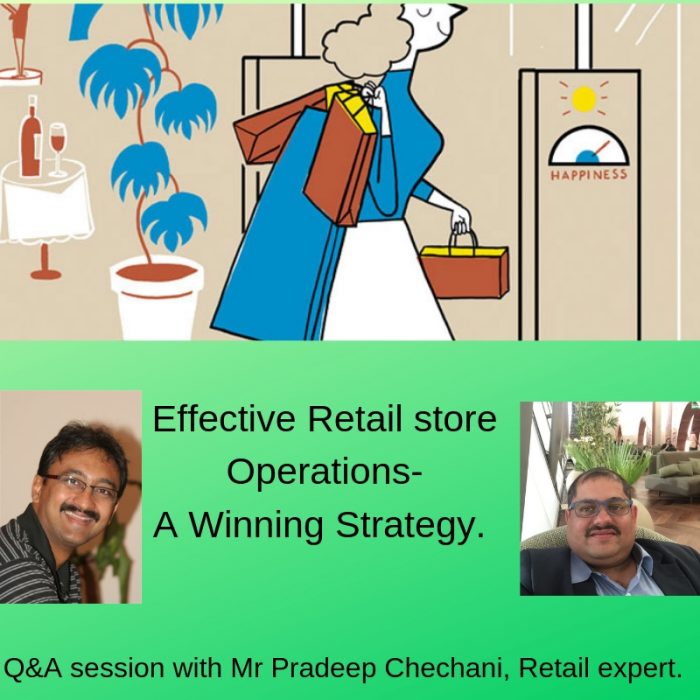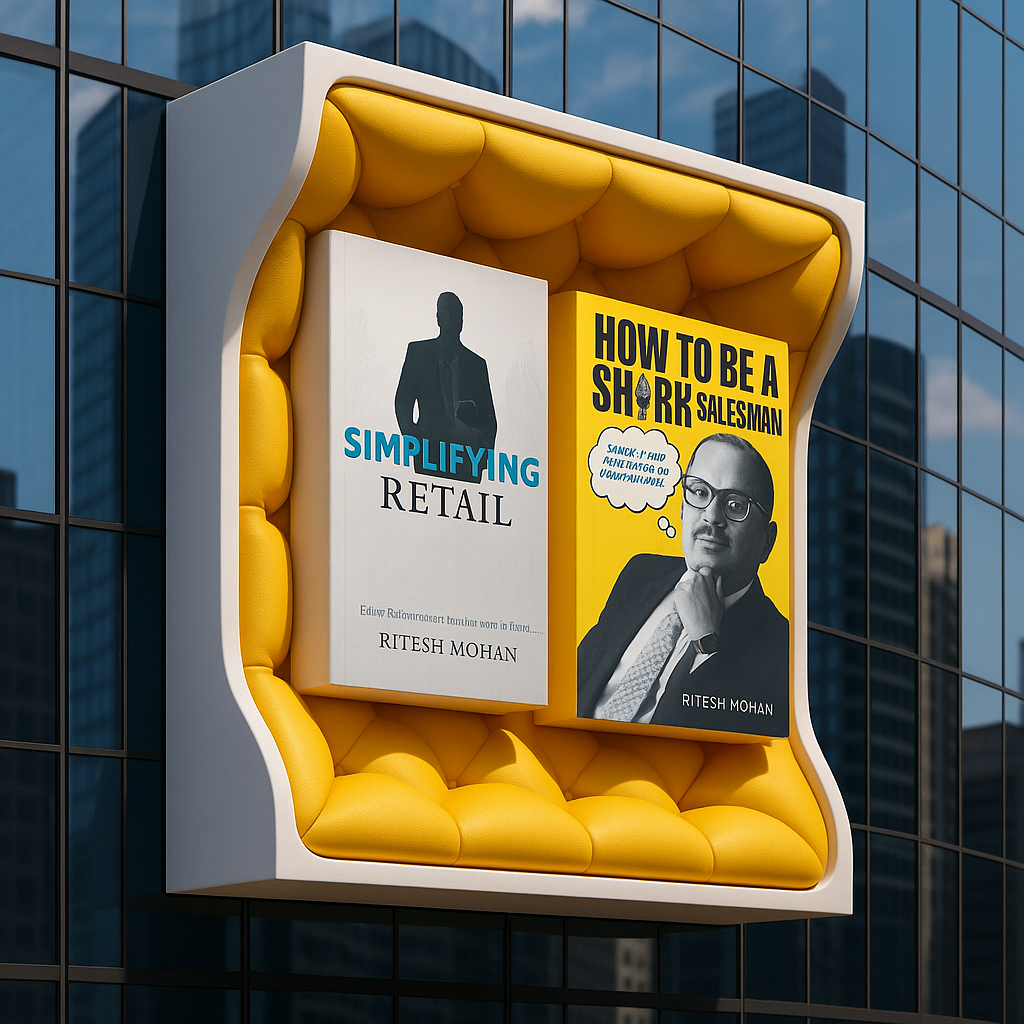Effective Retail Store Operations – A winning strategy.
Developing an effective store operations strategy & imparting the best customer service are the foremost priority of a retail manager or even the CEO of a retail organization.
The store remains the temple of your brand, and we all know that the customer is the king.
So how retailers are coping up with the “Listening to their customers needs” requirements?
Recently, I got an opportunity to talk to my retail fraternity member, my retail mentor and a good friend from India, Mr. Pradeep Chechani as we both had earlier worked together in the Middle East with one of the leading retailers.
Since we both shared our similar passion i.e. Retail management, it was important for me to bring Pradeep’s insights and share his wisdom with readers of my blog as it would be very beneficial to those who are entering into retail or want to make retail as their career.
Ladies & Gentlemen, Let me introduce you to Mr. Pradeep Chechani, a Retail professional with 20 + years of work experience. Well exposed to Fashion & Grocery retail verticals including fruits & veggies. Expert in functions like B&M, Planning, Supply Chain, Operations. Developed expertise in Omni-channel retail, Ecommerce & Digital Marketing, Process automation, Customer Experience Management.
Below are the excerpts of my interview with Mr. Pradeep Chechani.
Q1: what are the pain points of a store manager and how can we reduce those pain points in order to increase customer service efficiencies?
A1: Key Responsibilities of a Retail Store operations Manager is to
- Manage employees
- Control costs
- Manage merchandise
- Provide Customer Service
The top 3 responsibilities mentioned above can be managed with internal processes.
The business looks at continuously increasing the productivity of two of the most important assets: the firm’s investments in its employees and its real estate.
Traditionally, issues pertaining to merchandise management were considered the most important retail implementation decisions and buying was considered as the best career path.
Today, developing a strategic advantage through merchandise management is becoming more and more difficult.
Competing stores often have similar assortments of merchandise. Therefore servicing the customer through store management or convenience, have become a critical basis for developing a strategic advantage.
Learning tip:
You need to find a differentiator in your retail business model, your retail store or brand need to stand for something (for example Walmart positioning stands for everyday low prices).
Learn about the “ Power of Bundle” in merchandising planning, Read here.
Create mediums/channels to listen to your customer’s needs or grievances:
Often a retailer tends to lose ground because there is a delay in reacting to customer feedback and therefore they start losing customers and start to react only when it is too late.
One model that is fast becoming successful in quickly reacting to the ‘Voice of Customer’ is the ‘Service Gaps model’.
Retailers have started to adopt this model. Blended with technology, it becomes very effective. The basics of the model are like this:
There are essentially 4 types of gaps.
-
The Knowledge Gap
It is the difference between the Customer’s expectation for service quality and the retailer’s perception of customer expectation. Knowing what the customer wants requires a comprehensive study on the customer’s expectation and continuous interaction with her.
-
The Standards Gap
It is the difference between the retailer’s perception of customer expectation and the standards defined to fulfill this expectation.
-
The Delivery Gap
It highlights the difference between the defined standards and the actual service delivered.
-
The Communication Gap
It addresses the difference between the actual service delivered and the customer’s perception of that service quality. It also highlights the difference in the retailer’s communication of that service and the customer’s perception.
Q2: How can a store manager reduce the stock loss or stock variances which is the biggest margin eater for any retailer?
A2: Inventory is another big investment for a retailer. It has to be tracked with precision.
Few pointers for optimizing retail store operations:
a) Calculate shrinkage as an ‘absolute variance’ and not as a ‘net variance’. Both over & under inventory leads to sale loss and other inefficiencies within a store and across the supply chain.
b) Break down the entire inventory movement process in small logical processes and then start monitoring every subprocess. You are bound to identify the problem area.
c) Detecting and Preventing Shoplifting can be minimized by:
- Implementing the correct Store Design. Avoid too many pillars, keep the line of sight clear supported with CCTV system
- Employee Training
- Don’t assume that all shoplifters are poorly dressed
Read the article on Retail shrinkage and its control measures, click here
Q3. How can a store operations manager work closely with merchandise planning and Visual teams in order to increase the stock turnover or stock rotation?
A3: The support that the retail store operations usually provides is
a) Display merchandise, maintain visuals standards & follow planograms as directed for the store
b) Work closely with buyers in suggesting new merchandise based on customer feedback, buy merchandise wherever applicable, Plan & manage special promotions, Markdown merchandise, etc.
The advent of technology is making this process very accurate and speedy. We are seeing tech solutions taking customer feedback and publishing it internally and accurately via machine learning. So the manual element and errors are getting minimized.
Right merchandise in the right quantities with a visual appeal is bound to help the inventory throughput
Q4. What kind of customer service differentiation do you see both in India, in the middle east and the European markets? How can we improve our customer service aspect in case we lack the same when compared to western counterparts?
A4: India is all about volumes.
There are Indian hypermarket stores regularly getting almost 7 to 8k number of bills (NOBs) per day during the weekends. In festive season this goes up by two folds. The Middle East & Europe comparatively does not see this congestion.
The Indian labor is cheap and availability is good. Hence customer service is more via manpower than anything else.
One common trend which I see catching up in all these regions is giving convenience to the customer. Hence,various door to door delivery models is coming up which are supported very well by the last mile logistics. I see a lot of customer acquisition through this medium.
Learn about the business model of last-mile logistics, click here.
Q5. How can technology help to reduce the delivery and communication gap which you have mentioned in your answer?
A5: Tech solutions that cover the entire journey of the customer in a store and capture customer feedback in a convenient way help to reduce this gap.
The structured and unstructured feedback is processed via machine learning and categorized.
A retailer can then decipher & plug the communication and delivery gap.
I hope readers of my blog would have really liked the insights shared by Mr. Pradeep from his extensive experience in handling hypermarkets chain in India to some big e-commerce projects. His replies provide the elements of the retail store operations standard operating procedures.
As a retail professional, it is my duty to support upcoming retail professionals by providing them the right wisdom from industry professionals through the Q&A session on my blog. This is a first Q&A session and I promise to bring you more from industry experts.
In case any of my readers or retail fraternity member need any kind of advice or help then you may reach out to me at riteshmohan@yahoo.com.
Most importantly now, you can subscribe to retail insights on my blog by entering your valid email id.
You will get weekly updates on any new article that I would be publishing. This is one way of staying connected to retail insights and marketing strategies.
About the author:
Ritesh Mohan is a passionate retail professional with over 20 years in the Retail sector, handling some of the biggest brands in beauty, fashion and fragrances retail & FMCG sector. He has been instrumental in the growth of some of the regional brands as well in the Middle East region. Ritesh specializes in Retail management, Product development, and Brand Management, Retail Operations, Sales Management, and Franchising management. He strongly believes in empowering business owners with his wisdom & experience of around two decades in the industry.




